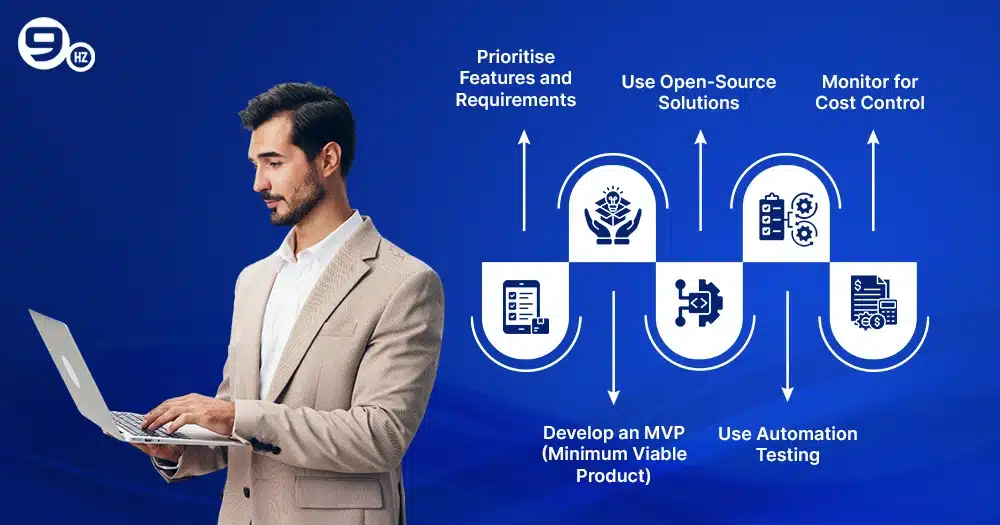The technology sector shapes industries like business, healthcare, retail, finance, and government. Emerging tech like Machine Learning or Artificial Intelligence (AI) has driven automation and personalisation for software development. In the digital age, companies prefer low-code and no-code development to transform ideas and allow businesses to deploy the best features. Each industry has its own workflows, challenges, and regulatory demands that developers consider to build strategic assets. As a result, software development services in Sweden are increasingly tailored to meet these sector-specific needs, delivering innovative and compliant solutions across diverse industries.
Overall, the global Sweden software development market is estimated at $3.7 billion by 2027, which will show a growth rate of 5.8% during the forecast period of 2022-2027. Cloud innovations like SaaS, LaaS, and PaaS also redevelop the process with a more flexible approach and adapt to agile development. The software development cost in Sweden will vary, depending on adopting the best practices, the size of the project, and the tech stack.
Here is a detailed blog to cover every aspect of software development cost in Sweden and the factors that affect overall project management.
Factors that Affect Software Development Costs
Software development has been a dynamic process that depends on multiple factors. Before stepping into the entire procedure, here are the considerable factors that determine the cost to develop software in Sweden:
Software Project Types
The software development cost in Sweden depends on the types of projects targeting different users and industries. Understanding your requirement will create a blueprint for development that comprises web applications, desktop software, enterprise solutions, cloud-based software, open-source projects, and DevOps tools.
Project Complexities
Software complexities relating to its features or hardware, and the scope of projects, can directly influence overall development costs. It is essential to assess whether you require a Minimum Viable Product (MVP) or advanced software that will add cost for extra developing hours, specialised skills, and resources.
Technology Stack
Your choices for tech stack in software development will account for balanced scalability, functionality, and long-term maintenance costs. Depending on the development complexities, you can select the right frontend tech stack like CSS, HTML, or JavaScript, and the backend, including web servers, Databases, frameworks, and programming languages. It can directly influence the overall software development costs.
Project Timeline
Considering the right time frame for software development is another factor affecting the overall costs. A shorter timeline for development can develop a product with minimal investment, while an extended timeline can increase cost due to overtime, resource acquisition, and hiring additional team members. Also, a delayed launch might add to opportunity costs.
In-House or Outsourcing Development
Whether you decide on in-house development or outsourcing with skilled developers, both methods have different cost implications. In-house development requires investment for a dedicated team, infrastructure, and maintenance costs. On the other hand, outsourcing can be cost-effective for short-term projects with hiring for specific expertise.
Software Testing and QA
Investing in comprehensive testing and QA (Quality Assurance) will save you from stressful maintenance and help you develop a bug-free product. It can lead to major cost savings and reduce the risk of post-launch bugs. Also, integrating automated testing tools like Cypress and Selenium can reduce upfront costs for setup.
Third-Party Integration
Integrating third-party tools and complex integrations requires more expertise and resources, which increases development costs. This comes as recurring costs that enhance your initial and ongoing budgets with custom configuration, data mapping, and validation investments.
Average Hourly Rates in Sweden
Have you wondered how much it costs for software development in Sweden? As a business looking to develop software, if you are hiring experts, you will require a diverse team to acquire them based on role and experience level. Here is the table to represent the estimated average hourly software development cost in Sweden:
| Role | Experience Level | Hourly Rate (SEK) | Hourly Rate (USD) |
|---|---|---|---|
| Junior Developer | 0–2 years | 400 – 600 | $38 – $57 |
| Mid-Level Developer | 2–5 years | 600 – 850 | $57 – $81 |
| Senior Developer | 5+ years | 850 – 1200 | $81 – $114 |
| Software Architect | 8+ years | 1000 – 1500 | $95 – $143 |
| DevOps Engineer | 3+ years | 800 – 1200 | $76 – $114 |
| Mobile App Developer | 2–5 years | 650 – 1000 | $62 – $95 |
| Full Stack Developer | 3–7 years | 700 – 1100 | $67 – $105 |
| UI/UX Designer (Tech) | 2–6 years | 600 – 950 | $57 – $90 |
| Project Manager (Software) | 5+ years | 900 – 1300 | $86 – $124 |
| Freelance Developer (General) | Varies | 700 – 1200 | $67 – $114 |
Software Development Cost by Project Type
Software development projects can be categorised into different types depending on their nature, size, and purpose. While the basic foundational steps, such as web designing or prototyping, coding, testing, deployment, and maintenance, remain consistent across software development, specific requirements for tech stack, platform integration, and user experience often vary depending on the project type.
So, here is the classification for software development cost in Sweden based on different projects:
| Category | Project Type | Cost Range (SEK) | Timeline |
|---|---|---|---|
| Beginner | Basic Website | 80,000 – 150,000 | 2 – 4 weeks |
| Corporate Website (CMS) | 120,000 – 250,000 | 4 – 6 weeks | |
| Intermediate | E-commerce Platform | 250,000 – 600,000 | 2 – 3 months |
| Mobile App (MVP) | 300,000 – 750,000 | 2 – 4 months | |
| Custom Web App (SaaS) | 400,000 – 1,000,000 | 3 – 6 months | |
| API Integration Project | 200,000 – 500,000 | 1 – 2 months | |
| Advanced | Game Development | 500,000 – 2,500,000+ | 6 – 12+ months |
| Enterprise Software | 1,000,000 – 3,000,000+ | 6 – 12+ months | |
| AI/ML-Based Application | 600,000 – 2,000,000+ | 4 – 8 months |
Please note that these are estimated costs which is subject to changes depending on team size, development tools, API integration like CRM, ERP, and payment gateways, and AI application for model training, data pipelines, and algorithm integrations.
In-House vs. Outsourced Development
As an entrepreneur and business owner, it is a critical decision to decide for in-house or outsource development. There is no one-size-fits-all choice for this, as it depends on the project requirements, business needs, budget, and long-term goals.
Developing in-house for software development requires following their process of recruitment, while software development outsourcing is the practice of delegating project delivery to third-party firms or freelancers.
In-House Software Development
One of the default ways of software development is where companies prefer to build the software team on-premises and maintain the development process in one place. Here, businesses hire internally and onboard experts who fit the required roles based on skills and expertise required to complete the project. So, instead of delegation, the company chose to manage the complete software development life cycle internally.
Pros of In-house Development
Customisation
In-house development implies ease of customisation for features, functionalities, and platform integrity that aligns with business processes. Beyond the off-the-shelf solutions, there can be adjustments for UI/UX design, workflow customisation, scalability, architecture, and language support.
Accountability
The internal development team will be accountable for any modification to software that complies with the company’s values, mission, and strategic objectives. It creates a sense of ownership and responsibility to work for the common organisation’s goal.
Better Control
Insourcing helps companies to get full control over the development process, which allows them to manage priorities, create quick changes, and align developing software with their strategic objectives.
Cons of In-House Development
Lack of specialisation
In-house development offers more flexibility, but it lacks specialisation in certain areas, as it relies on a wide range of software solutions. So, when it comes to dynamic tech like AI, cybersecurity, and blockchain, this creates certain challenges during development.
Overhead Expenses
It creates significant investment to acquire the right resources, tools, and personnel to hire and train, and to retain developers. An in-house IT development team covers expenses for office utilities, salaries, equipment, recruitment, administration, and security measures.
Searching Right Talent
As the world is chasing remote settings, it will be challenging to find the exact skill match and required level of experience specific to niches. Many times, the local talent pool might not fully align with your requirements.
Outsource Software Development
Software outsourcing means delegating the development and maintenance tasks to external third-party service providers. Following this strategic process, companies can count on offshore, nearshore, and onshore outsourcing depending on the company’s specific needs and objectives. It helps developing teams to focus on specialised expertise, reduce costs, and focus on their business operations.
Pros of Outsourced Development
Cost Effective
One of the most common reasons to opt for outsourcing is to reduce the burden of IT costs, including hiring and training in-house staff to maintain infrastructure and equipment costs.
Access to Specialised Skills
Outsourcing allows businesses to acquire the right talent with expertise and specialised skills that might not be present in in-house development. Outsourced professionals are hired with diversified experience and technical knowledge to deliver the right product.
Scalability
IT outsourcing provides for scalability to fit a company’s needs. During the peak hours and when changes for project requirements occur, it can easily handle workloads and quickly allocate resources.
Cons of Outsourced Development
Security and Privacy
As outsourcing involves transferring information to a third party, there is a risk that the vendor will end up sharing confidential information with others. These significant risks can be minimised through signed agreements and an NDA with vendors.
Communication Challenges
With outsourcing for software development, it becomes difficult to manage time zone differences and language restrictions that directly influence project coordination and responsiveness.
Quality Concerns
There is no direct control over the development team working on projects, which creates inconsistency for software quality. Specifically, if the project is allocated to different developers with diverse teamwork and services, it might create scalability issues.
Tips to Optimise Your Budget for Software Development
Managing your software development budget can be challenging, as if you pitch too low, there will be a shortage of resources, and in case you overestimate the budget, it will misallocate resources. Whether you are building with an in-house team or choosing outsourcing, it is essential to optimise budget allocation. Here are the best tips to follow:
Prioritise Features and Requirements
Setting up a list of features and requirements will help to set the right budget for software development and rank them based on order of importance. You can work on finding the right solution, which will use software, specific design, and layout requirements.
Develop an MVP (Minimum Viable Product)
Developers can focus on creating the simplest version of software to solve real problems for businesses. Following this approach saves money and allows for a faster launch by considering all the user feedback. Brands like Dropbox and Airbnb have also followed the same.
Use Open-Source Solutions
Open-source tools can be used for software development by exploring open-source libraries, frameworks, and APIs for fast deployment. For security, you can check for licensing and community support to find reliable solutions.
Use Automation Testing
Automation allows the team to focus on development while lowering long-term development costs, reducing manual errors, and saving more time. Using tools like Selenium or Jest, CI/CD pipelines, and code reviews, this reduces repetitive tasks.
Monitor for Cost Control
Following the strategic method to control software development expenses and maximise its value without compromising quality. Tracking the budget will help to improve financial predictability and enable resource efficiencies.
Why Choose Ninehertz to Develop Your Software?
NineHertz has been providing software development services for over 15 years with comprehensive choices that help businesses find the ideal fit solutions. With a record of over 1300 project deliveries and covering 100+ industry sectors, NineHertz will offer AI-based features at competitive software development costs in Sweden. Our dedicated team offers range of softwares customised for B2B, B2C, and B2D models, which comprises ERP, enterprise software, supply chain management, asset management, fleet management, and HR software.
Whether you want to hire on an hourly basis or a hybrid model, get a free estimate to discuss the cost to develop software in Sweden with our experts at NineHertz!
Conclusion
The core fundamentals for software development begin with following coding practices, adopting methodologies like DevOps and Agile, and navigating UI/UX designing. From developing user-friendly software interfaces to designing for complex systems, as technology advances, there is a significant increase in demand for software developers. Businesses often explore opportunities to find developers providing lower software development cost in Sweden who can recreate small ideas into innovative execution.
Frequently Asked Questions
What is the average cost of software development in Sweden?
The average cost for software development in Sweden can range between SEK 800 to 1500 per hour, and overall project costs vary between SEK 250000 to 2,00,000 depending on expertise, features, and complexities.
How long does it take to build a software product?
Based on the features and complexities, the timeline can range between 4 weeks to 12 months for building basic to advanced level software.
Is it better to hire in-house or outsource?
Both methods have their advantages. You can consider for in-house team for flexibility, better control, and long-term projects; on the other hand, outsourcing is more ideal for short-term projects with specific skill expertise.











